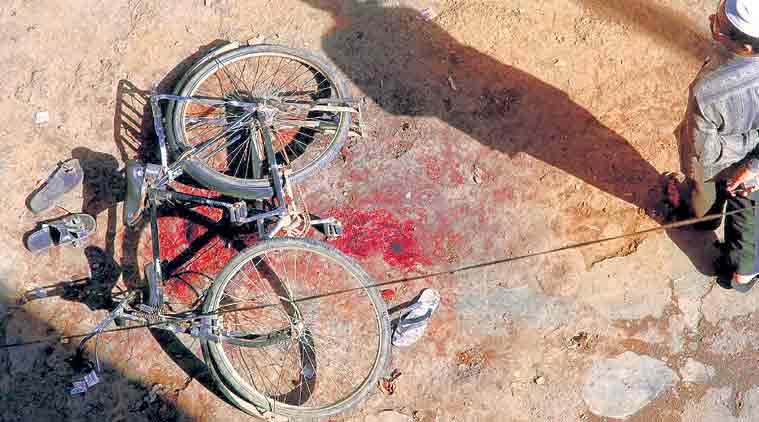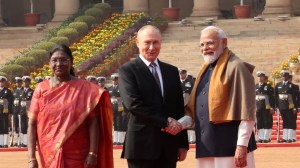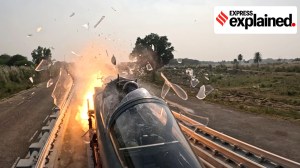Malegaon case: Two blasts, multiple chargesheets
Last week, the NIA informed a special court that it intended to drop charges under the stringent MCOCA against the 11 accused in the 2008 Malegaon blasts case. Indian Express explains the case, the one of two years earlier, and their many twists and turns.
 The blast took place near a hotel in Bhikku Chowk. The bomb was placed in a motorcycle. (Express archive)
The blast took place near a hotel in Bhikku Chowk. The bomb was placed in a motorcycle. (Express archive)
Two bomb blasts – one in September 2006 and the other in September 2008 – in the Muslim-dominated powerloom town of Malegaon in Maharashtra have together come to be known as the Malegaon cases. The two blasts killed over 40 people. Both cases were initially investigated by the Maharashtra Anti-Terrorism Squad (ATS) but are now with the National Investigation Agency (NIA).
In the first case (2006), the state agency chargesheeted 13 Muslim men who were alleged to be operatives of SIMI (the banned Students Islamic Movement of India) and connected to the Lashkar-e-Toiba (LeT). Of the 13, only nine were arrested as four were shown as absconding. Immediately after the ATS filed a chargesheet, acting on protests from Muslim groups, the state government transferred the case to the CBI in February 2007. The CBI agreed with the ATS investigations and filed a supplementary chargesheet supporting the ATS probe.
Meanwhile, on September 29, 2008, another blast ripped through Malegaon. The ATS once again took up the case. In October 2008, the ATS, under joint commissioner of police Hemant Karkare (who died in the 26/11 attacks a month later), for the first time unraveled a conspiracy by right-wing Hindu groups to spread terror in the country.
[related-post]
The agency first arrested Sadhvi Pragya Singh Thakur, a former ABVP activist. This was followed by arrests of army officer Lt Col Shrikant Prasad Purohit and retired Major Ramesh Upadhyay. The role of the right-wing outfit Abhinav Bharat, along with that of self-proclaimed Hindu seer Sudhakar Dwivedi, also came to light.
The ATS subsequently chargesheeted 14 accused in the 2008 Malegaon case before a special MCOCA court in Mumbai – Pragya Singh Thakur, Ramesh Upadhyay, Shrikant Prasad Purohit, Sameer Kulkarni, Rakesh Dhawade, Sudhakar Dwivedi a.k.a. Dayanand Pandey, Sudhakar Chaturvedi, Pravin Takalki, Shivnarayan Kalsangra, Shyam Sahu, Ajay alias Raja Rahirkar, Jagdish Mhatre, Ramchandra Kalsangra and Sandeep Dange. Of the 14, Shivnarayan Kalsangra, Shyam Sahu, Ajay alias Raja Rahirkar and Jagdish Mhatre are on bail while Ramchandra Kalsangra and Sandeep Dange are absconding.
Enter NIA
In December 2010, the CBI arrested Naba Kumar Sarkar alias Aseemanand. In a confession made before a magistrate, Aseemanand said both the Malegaon blasts were the handiwork of radical Hindu groups as a “revenge against jihadi terrorism”. He said the plan to target Muslims was hatched by a group led by former RSS pracharak Sunil Joshi. He said the group was also behind the 2007 blasts in Samjhauta Express, Ajmer Dargah and Hyderabad’s Mecca Masjid. Aseemanand later retracted his statement.
In early 2011, the Centre transferred both Malegaon cases, apart from the Mecca Masjid and Ajmer Dargah blast cases, to the NIA. The agency had already been investigating the Samjhauta Express blasts since 2010.
In November 2011, all nine Muslim men chargesheeted by ATS in 2006 Malegaon blasts case were granted bail. NIA did not oppose the bail and maintained it had no evidence against the nine accused.
The NIA’s findings
Through 2012, the NIA arrested four Hindu men in connection with the 2006 Malegaon blasts probe. In a chargesheet filed in May 2013, the agency named Manohar Narwaria, Rajendra Chaudhary, Dhan Singh and Lokesh Sharma (all in jail now). The chargesheet also mentioned Sunil Joshi, Ramchandra Kalsangra, Ramesh and Sandeep Dange as those involved in the blasts. Joshi is dead while the others are absconding. Ramchandra Kalsangra and Sandeep Dange were common accused in the chargesheets filed by both the NIA (in the 2006 case) and the Maharashtra ATS (in the 2008 Malegaon blasts). Status of 2008 probe
It’s been four years since the blast case of 2008 came to the NIA, but the agency is yet to file a chargesheet. The delay has been largely attributed to a string of petitions filed by the lawyers of Pragya Thakur and Purohit, besides others, in various courts, including the Supreme Court. Apart from seeking bail for the accused, these petitions have challenged the invocation of the Maharashtra Control of Organised Crime Act (MCOCA) against the accused, the need for their custodial interrogation and the jurisdiction of the NIA over the case.
It was only towards the close of last year that all the petitions were disposed of by the apex court and all bail applications rejected by a MCOCA court, thus clearing the way for NIA to complete investigations and file a chargesheet.
Although the agency has not got permission as yet to conduct custodial interrogation of the accused, it has decided to go ahead with filing a chargesheet.
The current controversy
Even as the NIA reels under allegations that it isn’t moving fast enough in the 2008 case — its former special public prosecutor Rohini Salian told The Indian Express in June 2015 that the agency put pressure on her to go slow in the case — it has written to the law ministry through the Ministry of Home Affairs for opinion on whether it can drop MCOCA charges against the accused in this case.
Dropping of MCOCA charges is likely to weaken the case as, under the Act, a confessional statement made in front of an SP-rank officer is admissible as evidence. The NIA has sought the ministry’s opinion because last year, the Supreme Court had cast doubts over the application of MCOCA against the accused. It had even said that there was not enough evidence against the accused to suggest that they could be charged under MCOCA.
Application of MCOCA requires the accused to have been chargesheeted twice earlier in criminal cases. Also, the Act requires the probe agency to prove that the accused were part of an organised crime syndicate and were committing the crime for pecuniary gains. NIA says such conditions are applicable to only one accused, Rakesh Dhawade. NIA sources say Maharashtra ATS invoked MCOCA against the other accused as they were associates of Dhawade. This, NIA sources say, may not stand the scrutiny of court.
Why the legal opinion
NIA is being cautious. Legal experts say NIA could have simply filed a final report before the court and said that in its findings, it did not see any reason to invoke MCOCA against the accused. In fact, framing of charges against the accused under any particular Act is the prerogative of the court and not the agency.
In a December 2012 order in Vinay Tyagi vs Irshad Ali case, Supreme Court had said: “Once a Report (chargesheet) under Section 173(2) of the (Criminal Procedure) Code has been filed, it can only be cancelled, proceeded further or case closed by the court of competent jurisdiction and that too in accordance with law. Neither the Police nor a specialised investigating agency has any right to cancel the said Report.”
In the present case, the NIA is virtually seeking opinion on MCOCA charges slapped by Maharashtra ATS in its chargesheet.
What happens now
If the law ministry gives an opinion in favour of dropping MCOCA charges and the NIA accepts it, the agency can file a chargesheet under sections of the Unlawful Activities Prevention Act that deals with acts of terrorism.
- 01
- 02
- 03
- 04
- 05






































